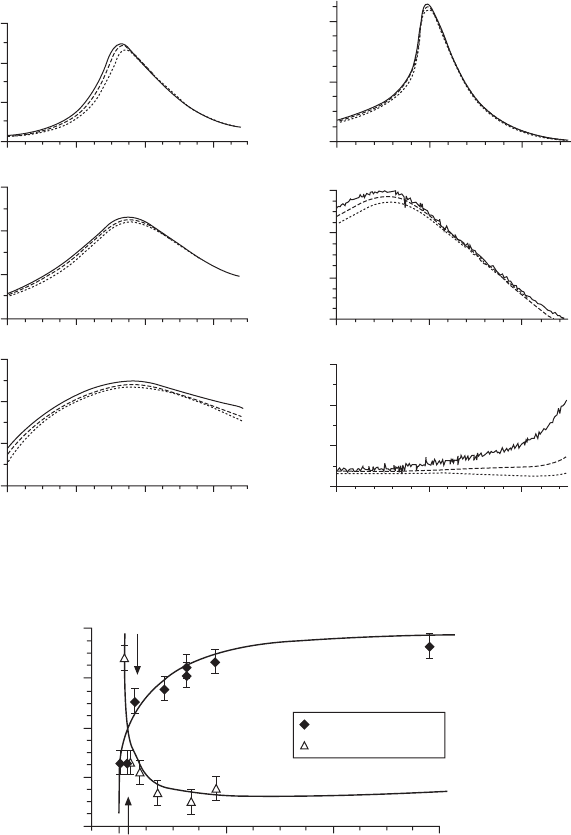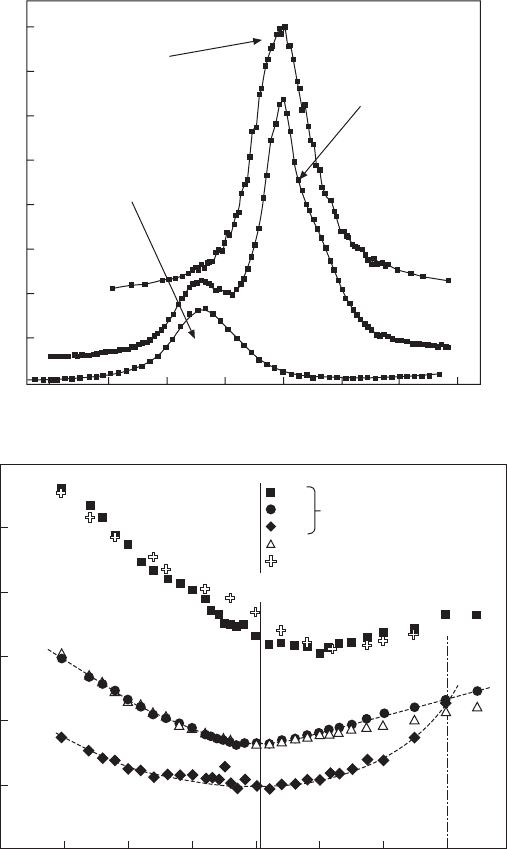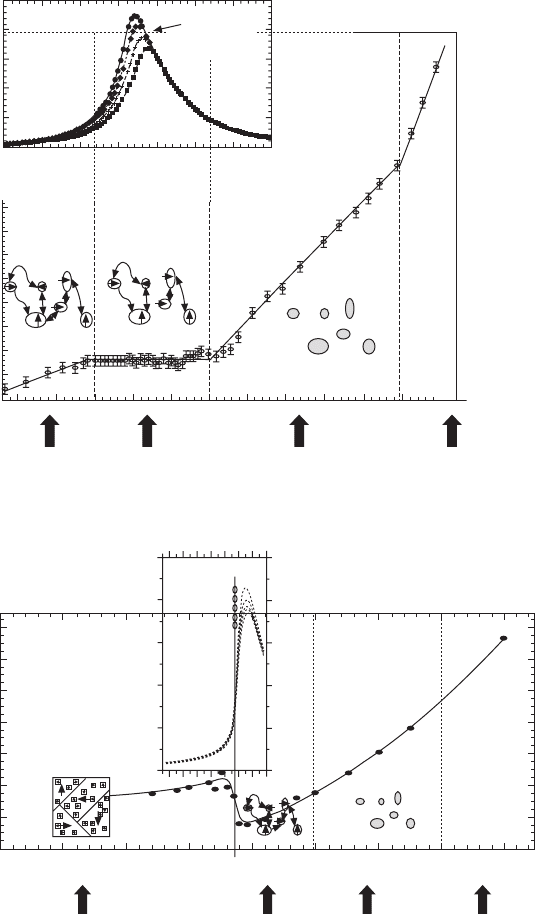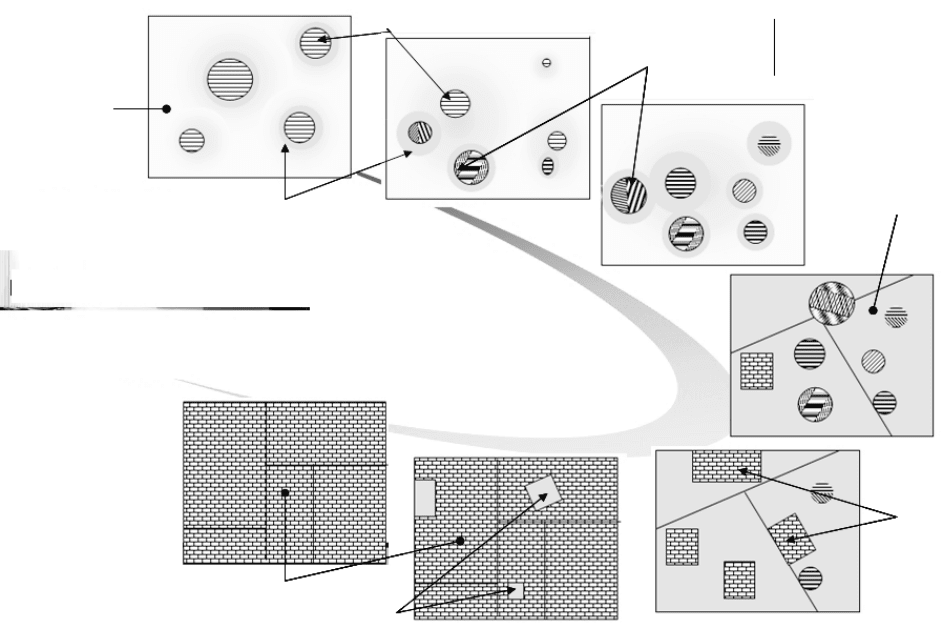Zuo-Guang. Ye Advanced Dielectric Piezoelectric and Ferroelectric Materials: Synthesis, Characterisation and Applications
Подождите немного. Документ загружается.

Handbook of dielectric, piezoelectric and ferroelectric materials430
[111] direction above a threshold value (1.7kV/cm), PMN transforms into a
rhombohedral phase at around 230K upon field cooling (Calvarin et al.,
1995). Interestingly, when the electric field is applied below the freezing
temperature, a time-dependent phase transition occurs (Vakhrushev et al.,
1997) with nucleation of polar rhombohedral nanodomains without growth
and after an incubation time, a percolation of these domains giving rise to a
microdomain state. Since these works and the discovery of monoclinic phases
in the MPB, E–T phase diagrams have been constructed in several studies for
[111]-oriented PMN (Sommer et al., 1993; Colla et al., 1996; Ye, 1998) and
PMN–PT (Emelyanov et al., 1993; Raevski et al., 2005) crystals. It is interesting
to notice that recent NMR investigations have also demonstrated the percolation
character of the induced phase transition in PMN (Blinc et al., 2003).
Furthermore, these NMR measurements have also revealed that although the
ferroelectric phase occurs, about 50% of the crystal remains in the glassy
matrix state, suggesting the polar inhomogeneities existing in these systems.
The same situation was also reported on PSN (Laguta et al., 2004).
Other relaxors and/or other crystal orientations have also been studied.
For instance a recent investigation on PZN showed that a monoclinic phase
can be induced when the electric field is applied along the [001] direction
(Lebon et al., 2005). However, some experimental results show that this
monoclinic phase could already exist without an electric field (see pages
416–22). PSN has also been recently studied by Samara and Venturini (2006)
and Venturini et al. (2006) who showed that a biasing electric field favours
the ferroelectric phase over the relaxor state, and that above 5kV/cm the
relaxor state vanishes.
Owing to the discovery of very high piezoelectric responses, the effort
has recently been concentrated on the MPB concentrations. For instance,
application of an electric field along the [001] direction on PZN–8%PT
induces the following phase sequence: rhombohedral → M
A
→ M
C
→
tetragonal. Interestingly, when the field is removed, the reverse sequence is
T → M
C
→ O. In PMN–35%PT a phase transformation sequence of cubic →
tetragonal → orthorhombic was found for E//110, whereas a sequence of
cubic → tetragonal → M
C
for E//001 was evidenced (Cao et al., 2006).
Recently Kutnjak et al. (2006) have shown that the giant electromechanical
response in PMN–29.5%PT and potentially in other ferroelectric relaxors is
the manifestation of a critical point inside the electrical field–temperature
phase diagram. They describe how, close to the critical point, both the energy
cost and the electric field necessary to induce ferroelectric polarization rotations
decrease significantly, thus explaining the giant electromechanical response
of these relaxors. This points out the extreme importance of these studies for
the understanding of the electromechanical properties of these materials for
technological applications.
WPNL2204

From the structure of relaxors to the structure of MPB 431
14.5.2 External pressure effect
A very good review paper by Samara and Venturini (2006) on this subject
has already been published. Among the results it is pointed out that at moderate
value (15kbar), the hydrostatic pressure is known to amplify the relaxor
behaviour of PMN by decreasing the correlation length associated with the
PNRs. In PZN–9.5%PT, up to 3kbar the main influence of pressure is a
decrease of T
c
but above 3kbar a ferroelectric to relaxor crossover is induced.
At higher pressure the structure is strongly changed in both systems with, at
a first stage, the disappearance of the polar behaviour as expected by the
continuous decrease of the correlation length of the polar regions. In the case
of the relaxor PZN (Janolin et al., 2006), which is characterised by a disordered
rhombohedral polar R3m phase, a homogeneous state is achieved at a pressure
of p
c1
≈ 5GPa. The new high pressure phase is consistent with a non-polar
R-3c space group associated with antiphase tilting of the oxygen octahedra,
similarly to PMN (Kreisel et al., 2002; Chaabane et al., 2003b) or PZN–
4.5%PT (Ahart et al., 2005), and is related to the appearance of new
superstructures on the diffraction patterns and a narrow peak at around
350 cm
–1
in the Raman spectra (Chaabane et al., 2004). It is noticeable that
the oxygen tilting appears only when the system becomes homogeneous.
With further increasing pressure, the octahedral tilt angle increases and the
R-3c structure is destabilised above p
c2
≈ 10GPa towards a monoclinic non-
polar C2/c structure, the tilt system being essentially conserved. Above p
c3
≈ 23GPa, a polar state reappears and is described by a monoclinic structure
with Cc space group which combines both ferroelectric and antiferrodistortive
instabilities (Janolin et al., 2006). The re-entrance of the polar state is similar
to recent observations for PbTiO
3
and is due to a new kind of ferroelectricity
(Kornev et al., 2005), that is driven by an original electronic effect, and can
be considered as a general feature of perovskites and related materials. The
monoclinic Cc phase has also been reported in such MPB systems as PZT
(Rouquette et al., 2005), with lower symmetries as triclinic P1 and
P1
.
The fact that the monoclinic phase is obtained in these systems at high
pressure suggests that this monoclinic phase may store an important strain
(energy), a key point for the understanding of the giant piezoelectric properties.
14.5.3 Grain size reduction effect
The question of ferroelectricity when size is reduced is an old problem which
has recently been revived owing to the experimental observation of polarisation
in nanocrystal of BaTiO
3
with a size as small as 70nm (Scott, 2006), in
contradiction with previous experimental and theoretical reports. Regarding
relaxors, we have recently addressed the question of reduction of size grains
in the ceramics (Carreaud et al., 2005) of PMN in which the dielectric
relaxation at size below around 30nm was found to disappear (Fig. 14.26).
WPNL2204
Handbook of dielectric, piezoelectric and ferroelectric materials432
The compounds of PMN–20%PT, which is just at the border of the MPB
region, and PMN–35%PT have also been studied. In the former, a path of
rotation from M
B
to M
A
is observed and below a critical value of ~200nm a
rhombohedral structure is stabilised (Carreaud et al., 2006), whereas the
latter displays a destruction of ferroelectric domain states toward PNRs with
typical sizes equal to the size of the grains below 200nm (Fig. 14.26b).
These effects are also discussed in connection with pressure experiments
and strain/field effects.
The sensibility to the reduction of size appears to be extreme. Although
not discussed in this chapter, it probably explains the so-called ‘X phase’
related to a probable skin effect, which has been well documented in BaTiO
3
for a long time. For further information the reader may consult the chapter
in this book on the grain size effect by Algueró et al., Chapter 15.
14.5.4 Rotation of polarisation in thin films
Evidently the study of thin films is going to take increasing interest in the
field of relaxor/MPB compounds. Several authors have studied temperature
dependence of dielectric properties in the thin films of PMN, PMN–PT, PSN
and PZT but up to now the question of structural evolution has only mainly
addressed in simple perovskites such PbTiO
3
and BaTiO
3
. We have recently
studied (Haumont et al., 2006b; Janolin, 2007) the thin films of PSN and
PSN–PT43% (i.e. inside the MPB) of various thickness, deposited on STO
and MgO substrates. In the former compound we have evidenced at room
temperature a polar tetragonal phase instead of the rhombohedral phase; this
raises the question of the existence of monoclinic phases for MPB PSN-PT
films, as in this case both PSN and PT have a polar tetragonal phase. However,
in the latter compound a single monoclinic Pm (M
C
) phase is nevertheless
observed whereas in bulk material this phase is mixed with a tetragonal
phase; this indicates that the origin of the monoclinic phase in films of
PSN-PT with morphotropic concentration is different from that of bulk
materials and is directly associated to the strains induced by the changing on
substrate. Depending on the substrate and the thickness, different domains
configuration are obtained (Fig. 14.27). Nevertheless, even in the polydomain
configurations observed in the thicker films, the stress is never completely
relaxed and induces complex structural evolution with temperature completely
different from that of bulk compound: in case of the MPB compound, at high
temperature, a succession of transformations toward a tetragonal non-polar
phase is observed and the cubic phase never reaches 95K.
14.6 Conclusions and future trends
In conclusion, we propose some simplistic pictures which summarise the
main ideas developed in this chapter.
WPNL2204

From the structure of relaxors to the structure of MPB 433
PMN
0.65 PMN–0.35PT
x
c
≈ 200 nm in PMN–35% PT
0 1000 2000 3000
D
(nm)
(b)
x
c
≈ 30 nm in PMN
∆
T
max
(K)
7
5
3
1
–1
14.26
(a) Temperature and grain size dependence of dielectric
constant in PMN (left) and in PMN–35%PT (right). Plain, dotted and
dashed lines correspond to frequency ranges between 1 and 100kHz
(b) Grain size dependence of dielectric relaxation, defined by
∆
T
ε
max
(
f
) =
T
(ε
max(f=100 kHz)
) –
T
(ε
max(f=10 kHz)
) for PMN and PMN–35%PT.
12000
8000
4000
0
1500
1000
500
0
125
115
105
95
ε
100 200 300 400
Temperature (K)
PMN PMN–PT35
900 nm
Relaxor
75 nm
Relaxor
15 nm
Non-relaxor
21 500
11500
1500
1200
1000
800
600
260
220
180
140
325 425 525
Temperature (K)
Non-ferroelectric
phase
15 nm
Relaxor
50 nm
Non-relaxor
675 nm
ε
(a)
WPNL2204

Handbook of dielectric, piezoelectric and ferroelectric materials434
14.27
(a) θ/2θ scans of (004) peak for PSN–PT film on MgO substrate
(300nm) and for two films of PSN–PT on STO with a 50nm and 300
nm thickness. (b) Temperature dependence of inter-reticular distance
of the
Pm
phase for different films.
Intensity (arb. units)
800
700
600
500
400
300
200
100
0
85.0 85.5 86.0 86.5 87.0 87.5 88.0 88.5
2θ(°)
(a)
PSN–PT/STO
50 nm
PSN–PT/MgO
300 nm
PSN–PT/STO
300 nm
4.080
4.070
4.060
4.050
4.040
4.030
4.020
200 300 400 500 600 700 800 900 1000
T
(K)
(b)
00L
H00 PSNPT on STO 300 nm
0K0
H00 – PSNPT on MgO 300 nm
00L – PSNPT on STO 50 nm
WPNL2204

From the structure of relaxors to the structure of MPB 435
14.6.1 Temperature evolution of the structure of relaxors
The physical situation can be roughly summarized by Table 14.1 and the
captions to Figs 14.28–14.31. We have reviewed some main experimental
results, even though many others, not described in this paper have been
reported. A ‘snap-shot’ close to and below the Burns temperature could
therefore give the schematic pictures, as shown in Fig. 14.28. Figure 14.29
Physical
pictures
Main
experimental
evidences
described in
this text
T
≤
T
f
• Complete
freezing of
PNRs in the
form of local
polar order,
coexisting with
eventual long-
range polar
order
• Lattice
parameter
anomaly
• Anisotropic
minimum in
agreement
factor versus
shifts
• Diffuse
scattering
• Vanishing of
dielectric peak
T
f
<
T
≤
T
*
• PNRs strongly
correlated, some
become static
• Lattice
accommodation
(monoclinic)
between CORs
(tetragonal) and
PNRs
(rhombohedral )
• Eventually at
T
c
with
T
c
<
T
* :
appearance of
long-range polar
order (PSN,
PMN–PT and
other related
systems)
• Lattice
parameter
anomaly
• Raman
anomalies
• Anisotropic
minimum in
agreement
factor versus
shifts
• Diffuse
scattering with
eventual critical
component
• Dielectric
maximum,
relaxation with
T
max(ω)
T
* <
T
=
T
B
• At
T
B
displacements
gradually have
slow down
and correlate,
forming
dynamic PNRs
weakly
correlated
• CORs/CIRs
may act as
nucleation
centre for the
PNRs
• Lattice
parameter
anomaly
• Raman
anomalies
• Anharmonic
thermal
parameter,
isotopic
minimum in
agreement
factor versus
shifts
Table 14.1
Brief and simplistic summary of the temperature evolution of the
structure of a relaxor.
T
B
<<
T
• Isotropic but
highly
anharmonic
dynamical
displacements
of the lead
along a
spherical shell
• Chemical
ordered regions
(CORs/CIRs)
with local
composition
different from
the bulk exist in
the samples
(whatever
T
is)
• Anharmonic
thermal
parameter,
isotropic
minimum in
agreement
factor versus
shifts
• Superstructure
peaks (CORs)
whatever
T
is
• Raman
scattering
(CORs/CIRs)
(whatever
T
is)
T
f
= freezing temperature;
T
* = temperature when diffuse scattering appears on cooling;
T
c
=
critical temperature (for compounds with phase transition);
T
B
= Burns temperature when
PNRs are created.
WPNL2204

Handbook of dielectric, piezoelectric and ferroelectric materials436
Chemical inhomogeneity
Accommodation region
Short-range polar region
Paraelectric matrix
T
≈
T
*
(a)
Chemical inhomogeneity
Short-range polar region
Paraelectric matrix
T
<
T
B
(b)
14.28
Schematic picture of the ‘structure’ of a relaxor close to
T
B
and
close to
T
*. The arrows symbolise the correlations. Note that many
details are not addressed in this picture, in particular the questions
of dynamic versus static displacements.
WPNL2204

From the structure of relaxors to the structure of MPB 437
14.29
Schematic picture of temperature-dependence of the ‘structure’
of a PMN-like relaxor (a) and a PSN-like ferroelectric relaxor (b).
T
C
T
*
T
B
100 200 300 400 500 600 700 800
Complete freezing Strongly Weakly Uncorrelated
of PNRs and correlated correlated dynamical
macroscopic dynamical and dynamical motions of
polarisation static PNRs PNRs individual atoms
4.092 Å
4.086 Å
4.078 Å
280
300
320
340
360
380
400
420
T(K)
2000
1600
1200
800
400
1
(b)
T
max
20000
15000
10000
5000
0
100 200 300 400
4.050 Å
4.045 Å
T
F
T
*
T
B
100 200 300 400 500 600
Complete Strongly correlated Weakly correlated Uncorrelated
freezing dynamical and dynamical PNRs dynamical motion
of PNRs static PNRs of individual atoms
(a)
WPNL2204
Handbook of dielectric, piezoelectric and ferroelectric materials438
shows the comparative evolution of PMN and PSN (and other relaxors with
ferroelectric phase).
Of course these pictures should not be taken as being exact and definitive,
in particular, regarding the accuracy of the different temperatures as well as
the notion of PNRs or CORs with well defined ‘domains’ and sharp boundaries.
Indeed, at a ‘zero’ level diffraction/diffuse scattering experiments do not
allow us to differentiate a ‘cake with grapefruit’ model (as depicted in Figs
14.30 and Fig. 14.31), implying nanodomains with sharp boundaries inside
a matrix) from a ‘cake with grape flavour’ model, i.e. a situation in which the
polar order does not form a boundary but is characterised by a correlation
length exponentially decaying and penetrating the whole sample. In fact, the
situation appears to be probably much more complex than these two extreme
(limiting) cases. Indeed by the careful fittings of diffuse scattering profiles,
‘fractal’ or ‘hierarchical’ organisation of the PNRs is possible. Clarification
of the situation is left for the future.
Many other questions are still unsolved, among them the coexistence and
the structure of the ‘frozen’ PNRs inside the ferroelectric domain states
which is probably much more complicated than a simple rhombohedral or
monoclinic local symmetry. One proposal is to use below the freezing
temperature T
f
, the term SPNRs (static polar nanoregions) instead of PNRs.
14.6.2 The concentration evolution of MPB systems:
MPB or morphotropic phase region?
We have discussed in the above sections that the monoclinic polar order already
exists in ‘pure’ relaxors in the form of PNRs or in connection with PNRs
(SPNRs). When doping with PT this polar order progressively develops in the
form of long-range ferroelectrics phases. We have seen that the CORs which
act as nucleation centres for the PNRs also transforms into chemical
inhomogeneous regions (CIRs) characterised by very local fluctuation or
segregation of titanium which may act as nucleation centres for the monoclinic
MPB phases. How the CORs transform into the CIRs when doping with titanium
is a question that is not yet clearly understood. So, although further experiments
are clearly needed to understand the nanoscale cation distribution, a possible
global simplistic picture of polar and chemical distributions with increasing
content of PT can be drawn to summarise what has been discussed (Fig. 14.30).
This picture points out the important fact that the relaxors and the MPB
systems are highly inhomogeneous and may be viewed as some kind of
composite materials (Fig. 14.31) in which nanoregions of local compositions
and of ferroelectric displacements coexist, forming self-organised nanostructured
systems. The notion of a matrix of average composition and average symmetry
that embeds these nanoregions is probably not correct as discussed above, but
it remains important at least for getting a rough picture of these systems.
WPNL2204

From the structure of relaxors to the structure of MPB 439
Cubic or
rhombohedral
matrix
PMN, PSN, PZN
Microscopic mechanism
PbTiO
3
Tetragonal matrix
Monoclinic regions
Increasing
amount of
titanium
Local monoclinic
distortion (region
under constraint)
Ordered 1:1 region
Ordered
nanoregions
Ti segregation
charged regions
Monoclinic
symmetry
Tetragonal
regions
14.30
Low-temperature structure versus the concentration of the titanium of MPB relaxors/compounds.
WPNL2204
